Cloud and Enterprise Computing: Banking Sector Technology Report
VerifiedAdded on 2022/11/11
|6
|2040
|254
Report
AI Summary
This report delves into the application of Information and Communication Technology (ICT) within the banking sector, focusing on the utilization of mainframe and cloud technologies. It begins by outlining the core business services offered by banks, such as accepting deposits, advancing loans, and foreign currency exchange, emphasizing the importance of security and privacy. The report then examines the different types of ICT workloads banks require, including batch workloads for processing large datasets and transactional workloads for customer order processing. It also highlights the benefits of cloud computing, such as improved manageability, scalability, and accessibility. Furthermore, the report discusses why major banks continue to use mainframes, particularly for processing high volumes of data and supporting various functions simultaneously. The conclusion summarizes the key findings, emphasizing the significant impact of ICT implementation on banking operations.
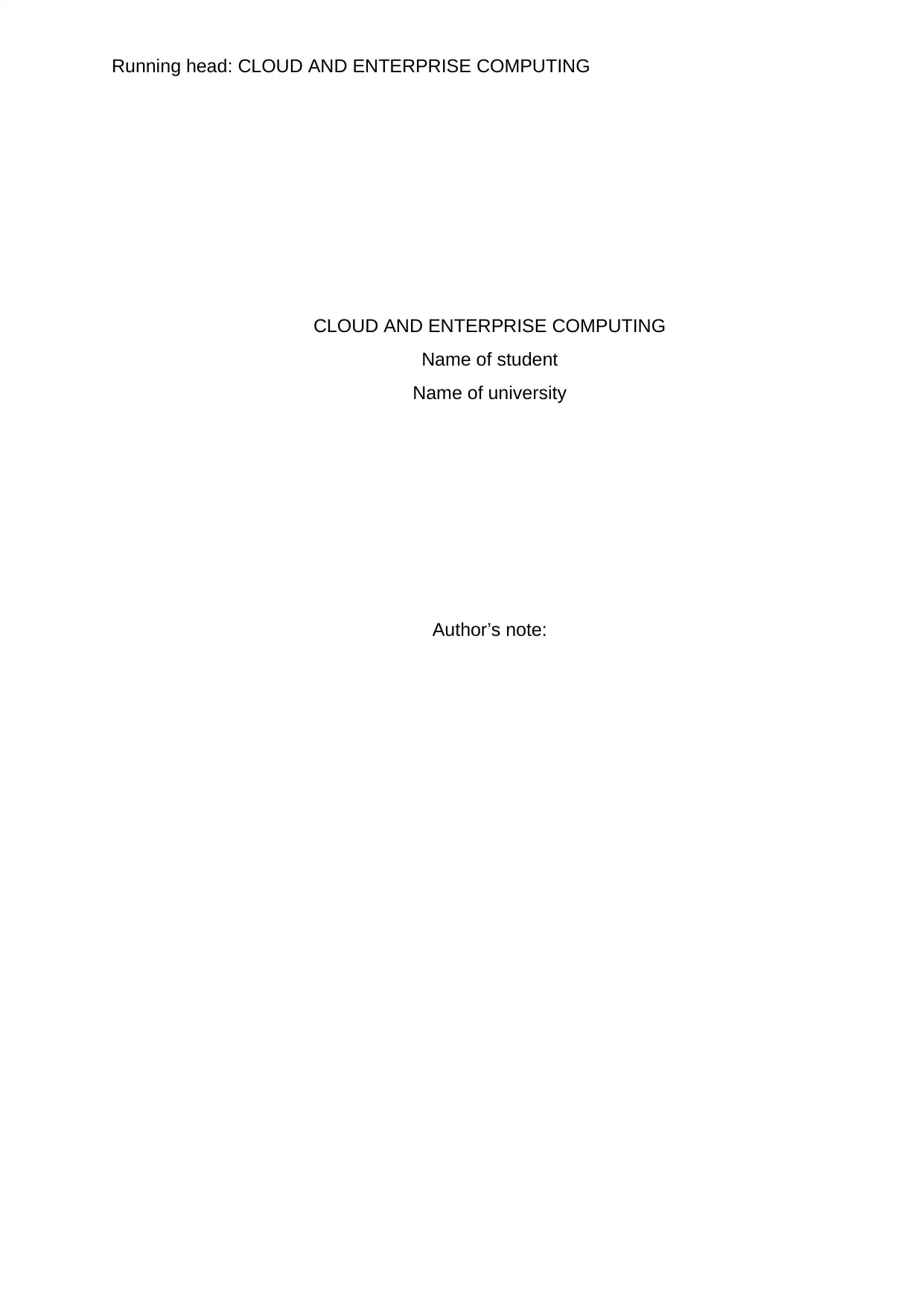
Running head: CLOUD AND ENTERPRISE COMPUTING
CLOUD AND ENTERPRISE COMPUTING
Name of student
Name of university
Author’s note:
CLOUD AND ENTERPRISE COMPUTING
Name of student
Name of university
Author’s note:
Paraphrase This Document
Need a fresh take? Get an instant paraphrase of this document with our AI Paraphraser
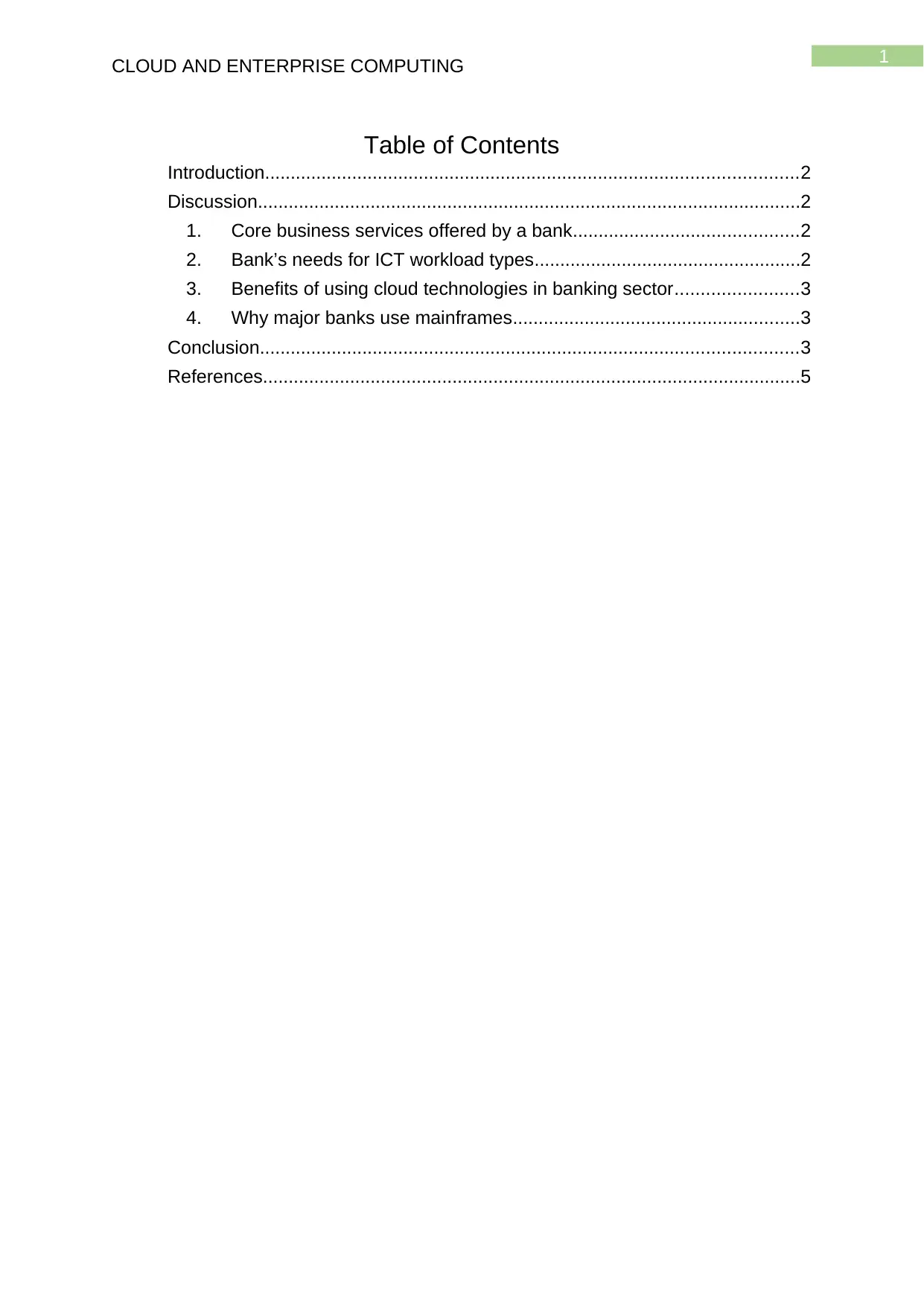
1
CLOUD AND ENTERPRISE COMPUTING
Table of Contents
Introduction........................................................................................................2
Discussion..........................................................................................................2
1. Core business services offered by a bank............................................2
2. Bank’s needs for ICT workload types....................................................2
3. Benefits of using cloud technologies in banking sector........................3
4. Why major banks use mainframes........................................................3
Conclusion.........................................................................................................3
References.........................................................................................................5
CLOUD AND ENTERPRISE COMPUTING
Table of Contents
Introduction........................................................................................................2
Discussion..........................................................................................................2
1. Core business services offered by a bank............................................2
2. Bank’s needs for ICT workload types....................................................2
3. Benefits of using cloud technologies in banking sector........................3
4. Why major banks use mainframes........................................................3
Conclusion.........................................................................................................3
References.........................................................................................................5
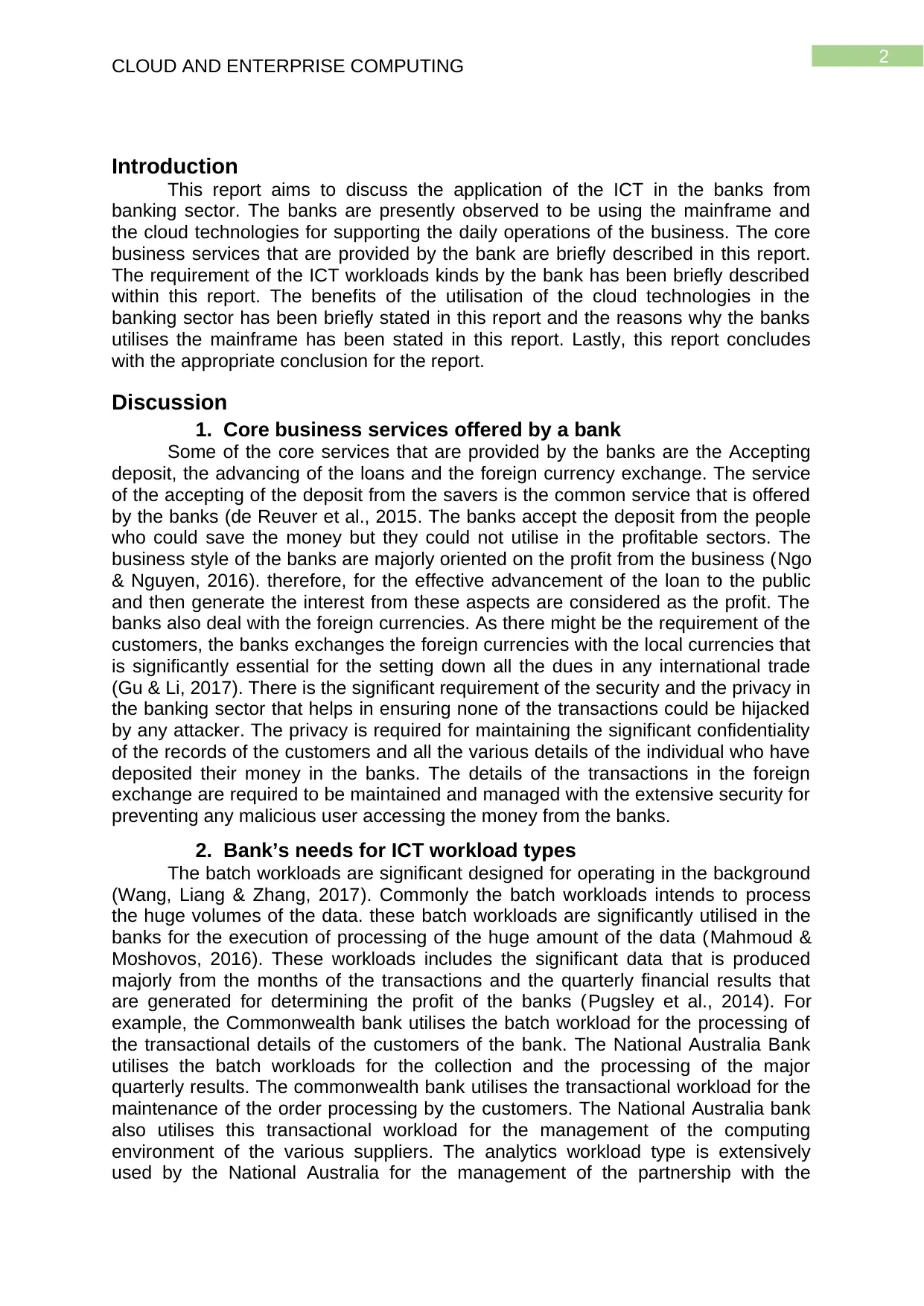
2
CLOUD AND ENTERPRISE COMPUTING
Introduction
This report aims to discuss the application of the ICT in the banks from
banking sector. The banks are presently observed to be using the mainframe and
the cloud technologies for supporting the daily operations of the business. The core
business services that are provided by the bank are briefly described in this report.
The requirement of the ICT workloads kinds by the bank has been briefly described
within this report. The benefits of the utilisation of the cloud technologies in the
banking sector has been briefly stated in this report and the reasons why the banks
utilises the mainframe has been stated in this report. Lastly, this report concludes
with the appropriate conclusion for the report.
Discussion
1. Core business services offered by a bank
Some of the core services that are provided by the banks are the Accepting
deposit, the advancing of the loans and the foreign currency exchange. The service
of the accepting of the deposit from the savers is the common service that is offered
by the banks (de Reuver et al., 2015. The banks accept the deposit from the people
who could save the money but they could not utilise in the profitable sectors. The
business style of the banks are majorly oriented on the profit from the business (Ngo
& Nguyen, 2016). therefore, for the effective advancement of the loan to the public
and then generate the interest from these aspects are considered as the profit. The
banks also deal with the foreign currencies. As there might be the requirement of the
customers, the banks exchanges the foreign currencies with the local currencies that
is significantly essential for the setting down all the dues in any international trade
(Gu & Li, 2017). There is the significant requirement of the security and the privacy in
the banking sector that helps in ensuring none of the transactions could be hijacked
by any attacker. The privacy is required for maintaining the significant confidentiality
of the records of the customers and all the various details of the individual who have
deposited their money in the banks. The details of the transactions in the foreign
exchange are required to be maintained and managed with the extensive security for
preventing any malicious user accessing the money from the banks.
2. Bank’s needs for ICT workload types
The batch workloads are significant designed for operating in the background
(Wang, Liang & Zhang, 2017). Commonly the batch workloads intends to process
the huge volumes of the data. these batch workloads are significantly utilised in the
banks for the execution of processing of the huge amount of the data (Mahmoud &
Moshovos, 2016). These workloads includes the significant data that is produced
majorly from the months of the transactions and the quarterly financial results that
are generated for determining the profit of the banks (Pugsley et al., 2014). For
example, the Commonwealth bank utilises the batch workload for the processing of
the transactional details of the customers of the bank. The National Australia Bank
utilises the batch workloads for the collection and the processing of the major
quarterly results. The commonwealth bank utilises the transactional workload for the
maintenance of the order processing by the customers. The National Australia bank
also utilises this transactional workload for the management of the computing
environment of the various suppliers. The analytics workload type is extensively
used by the National Australia for the management of the partnership with the
CLOUD AND ENTERPRISE COMPUTING
Introduction
This report aims to discuss the application of the ICT in the banks from
banking sector. The banks are presently observed to be using the mainframe and
the cloud technologies for supporting the daily operations of the business. The core
business services that are provided by the bank are briefly described in this report.
The requirement of the ICT workloads kinds by the bank has been briefly described
within this report. The benefits of the utilisation of the cloud technologies in the
banking sector has been briefly stated in this report and the reasons why the banks
utilises the mainframe has been stated in this report. Lastly, this report concludes
with the appropriate conclusion for the report.
Discussion
1. Core business services offered by a bank
Some of the core services that are provided by the banks are the Accepting
deposit, the advancing of the loans and the foreign currency exchange. The service
of the accepting of the deposit from the savers is the common service that is offered
by the banks (de Reuver et al., 2015. The banks accept the deposit from the people
who could save the money but they could not utilise in the profitable sectors. The
business style of the banks are majorly oriented on the profit from the business (Ngo
& Nguyen, 2016). therefore, for the effective advancement of the loan to the public
and then generate the interest from these aspects are considered as the profit. The
banks also deal with the foreign currencies. As there might be the requirement of the
customers, the banks exchanges the foreign currencies with the local currencies that
is significantly essential for the setting down all the dues in any international trade
(Gu & Li, 2017). There is the significant requirement of the security and the privacy in
the banking sector that helps in ensuring none of the transactions could be hijacked
by any attacker. The privacy is required for maintaining the significant confidentiality
of the records of the customers and all the various details of the individual who have
deposited their money in the banks. The details of the transactions in the foreign
exchange are required to be maintained and managed with the extensive security for
preventing any malicious user accessing the money from the banks.
2. Bank’s needs for ICT workload types
The batch workloads are significant designed for operating in the background
(Wang, Liang & Zhang, 2017). Commonly the batch workloads intends to process
the huge volumes of the data. these batch workloads are significantly utilised in the
banks for the execution of processing of the huge amount of the data (Mahmoud &
Moshovos, 2016). These workloads includes the significant data that is produced
majorly from the months of the transactions and the quarterly financial results that
are generated for determining the profit of the banks (Pugsley et al., 2014). For
example, the Commonwealth bank utilises the batch workload for the processing of
the transactional details of the customers of the bank. The National Australia Bank
utilises the batch workloads for the collection and the processing of the major
quarterly results. The commonwealth bank utilises the transactional workload for the
maintenance of the order processing by the customers. The National Australia bank
also utilises this transactional workload for the management of the computing
environment of the various suppliers. The analytics workload type is extensively
used by the National Australia for the management of the partnership with the
⊘ This is a preview!⊘
Do you want full access?
Subscribe today to unlock all pages.

Trusted by 1+ million students worldwide
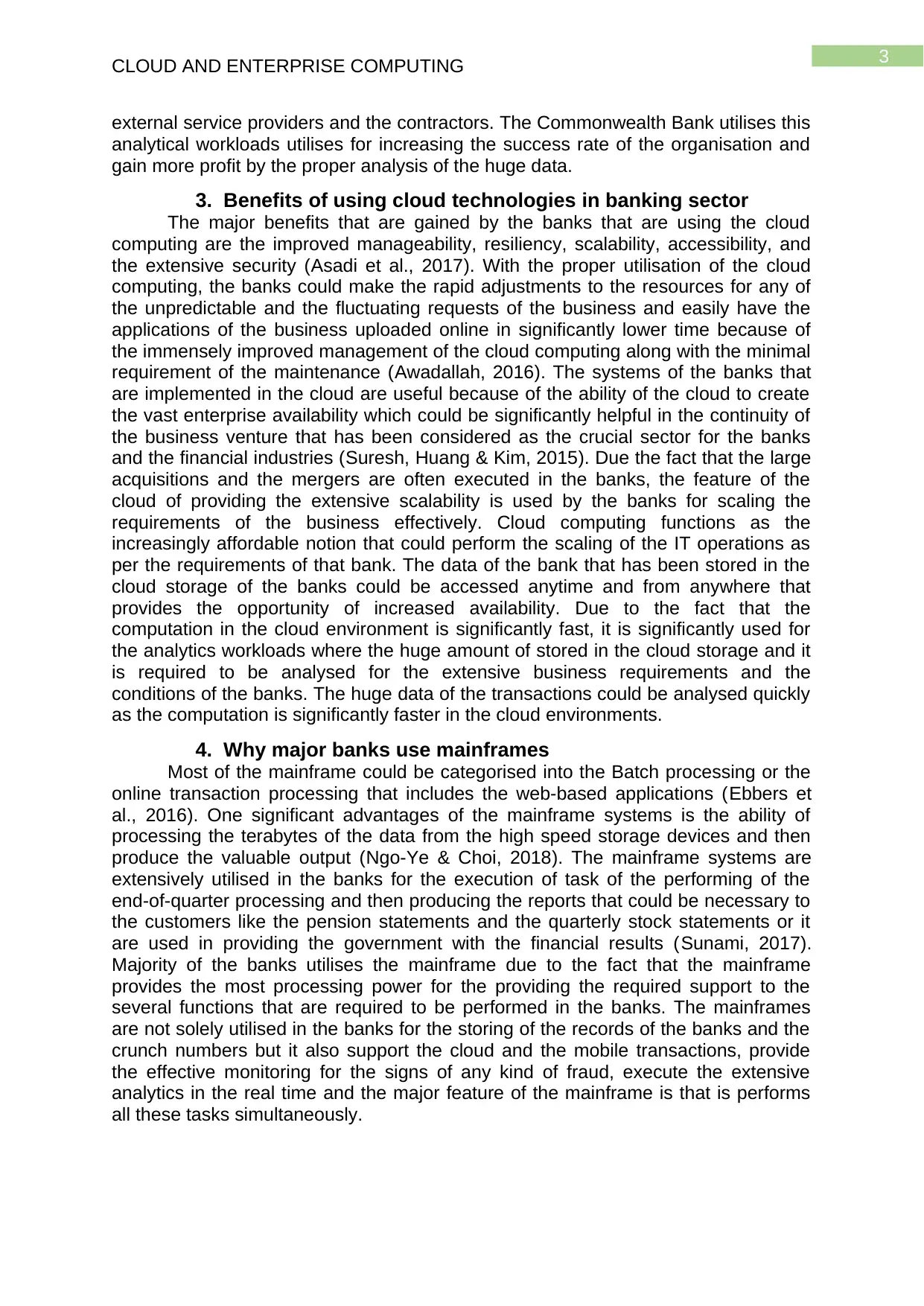
3
CLOUD AND ENTERPRISE COMPUTING
external service providers and the contractors. The Commonwealth Bank utilises this
analytical workloads utilises for increasing the success rate of the organisation and
gain more profit by the proper analysis of the huge data.
3. Benefits of using cloud technologies in banking sector
The major benefits that are gained by the banks that are using the cloud
computing are the improved manageability, resiliency, scalability, accessibility, and
the extensive security (Asadi et al., 2017). With the proper utilisation of the cloud
computing, the banks could make the rapid adjustments to the resources for any of
the unpredictable and the fluctuating requests of the business and easily have the
applications of the business uploaded online in significantly lower time because of
the immensely improved management of the cloud computing along with the minimal
requirement of the maintenance (Awadallah, 2016). The systems of the banks that
are implemented in the cloud are useful because of the ability of the cloud to create
the vast enterprise availability which could be significantly helpful in the continuity of
the business venture that has been considered as the crucial sector for the banks
and the financial industries (Suresh, Huang & Kim, 2015). Due the fact that the large
acquisitions and the mergers are often executed in the banks, the feature of the
cloud of providing the extensive scalability is used by the banks for scaling the
requirements of the business effectively. Cloud computing functions as the
increasingly affordable notion that could perform the scaling of the IT operations as
per the requirements of that bank. The data of the bank that has been stored in the
cloud storage of the banks could be accessed anytime and from anywhere that
provides the opportunity of increased availability. Due to the fact that the
computation in the cloud environment is significantly fast, it is significantly used for
the analytics workloads where the huge amount of stored in the cloud storage and it
is required to be analysed for the extensive business requirements and the
conditions of the banks. The huge data of the transactions could be analysed quickly
as the computation is significantly faster in the cloud environments.
4. Why major banks use mainframes
Most of the mainframe could be categorised into the Batch processing or the
online transaction processing that includes the web-based applications (Ebbers et
al., 2016). One significant advantages of the mainframe systems is the ability of
processing the terabytes of the data from the high speed storage devices and then
produce the valuable output (Ngo-Ye & Choi, 2018). The mainframe systems are
extensively utilised in the banks for the execution of task of the performing of the
end-of-quarter processing and then producing the reports that could be necessary to
the customers like the pension statements and the quarterly stock statements or it
are used in providing the government with the financial results (Sunami, 2017).
Majority of the banks utilises the mainframe due to the fact that the mainframe
provides the most processing power for the providing the required support to the
several functions that are required to be performed in the banks. The mainframes
are not solely utilised in the banks for the storing of the records of the banks and the
crunch numbers but it also support the cloud and the mobile transactions, provide
the effective monitoring for the signs of any kind of fraud, execute the extensive
analytics in the real time and the major feature of the mainframe is that is performs
all these tasks simultaneously.
CLOUD AND ENTERPRISE COMPUTING
external service providers and the contractors. The Commonwealth Bank utilises this
analytical workloads utilises for increasing the success rate of the organisation and
gain more profit by the proper analysis of the huge data.
3. Benefits of using cloud technologies in banking sector
The major benefits that are gained by the banks that are using the cloud
computing are the improved manageability, resiliency, scalability, accessibility, and
the extensive security (Asadi et al., 2017). With the proper utilisation of the cloud
computing, the banks could make the rapid adjustments to the resources for any of
the unpredictable and the fluctuating requests of the business and easily have the
applications of the business uploaded online in significantly lower time because of
the immensely improved management of the cloud computing along with the minimal
requirement of the maintenance (Awadallah, 2016). The systems of the banks that
are implemented in the cloud are useful because of the ability of the cloud to create
the vast enterprise availability which could be significantly helpful in the continuity of
the business venture that has been considered as the crucial sector for the banks
and the financial industries (Suresh, Huang & Kim, 2015). Due the fact that the large
acquisitions and the mergers are often executed in the banks, the feature of the
cloud of providing the extensive scalability is used by the banks for scaling the
requirements of the business effectively. Cloud computing functions as the
increasingly affordable notion that could perform the scaling of the IT operations as
per the requirements of that bank. The data of the bank that has been stored in the
cloud storage of the banks could be accessed anytime and from anywhere that
provides the opportunity of increased availability. Due to the fact that the
computation in the cloud environment is significantly fast, it is significantly used for
the analytics workloads where the huge amount of stored in the cloud storage and it
is required to be analysed for the extensive business requirements and the
conditions of the banks. The huge data of the transactions could be analysed quickly
as the computation is significantly faster in the cloud environments.
4. Why major banks use mainframes
Most of the mainframe could be categorised into the Batch processing or the
online transaction processing that includes the web-based applications (Ebbers et
al., 2016). One significant advantages of the mainframe systems is the ability of
processing the terabytes of the data from the high speed storage devices and then
produce the valuable output (Ngo-Ye & Choi, 2018). The mainframe systems are
extensively utilised in the banks for the execution of task of the performing of the
end-of-quarter processing and then producing the reports that could be necessary to
the customers like the pension statements and the quarterly stock statements or it
are used in providing the government with the financial results (Sunami, 2017).
Majority of the banks utilises the mainframe due to the fact that the mainframe
provides the most processing power for the providing the required support to the
several functions that are required to be performed in the banks. The mainframes
are not solely utilised in the banks for the storing of the records of the banks and the
crunch numbers but it also support the cloud and the mobile transactions, provide
the effective monitoring for the signs of any kind of fraud, execute the extensive
analytics in the real time and the major feature of the mainframe is that is performs
all these tasks simultaneously.
Paraphrase This Document
Need a fresh take? Get an instant paraphrase of this document with our AI Paraphraser
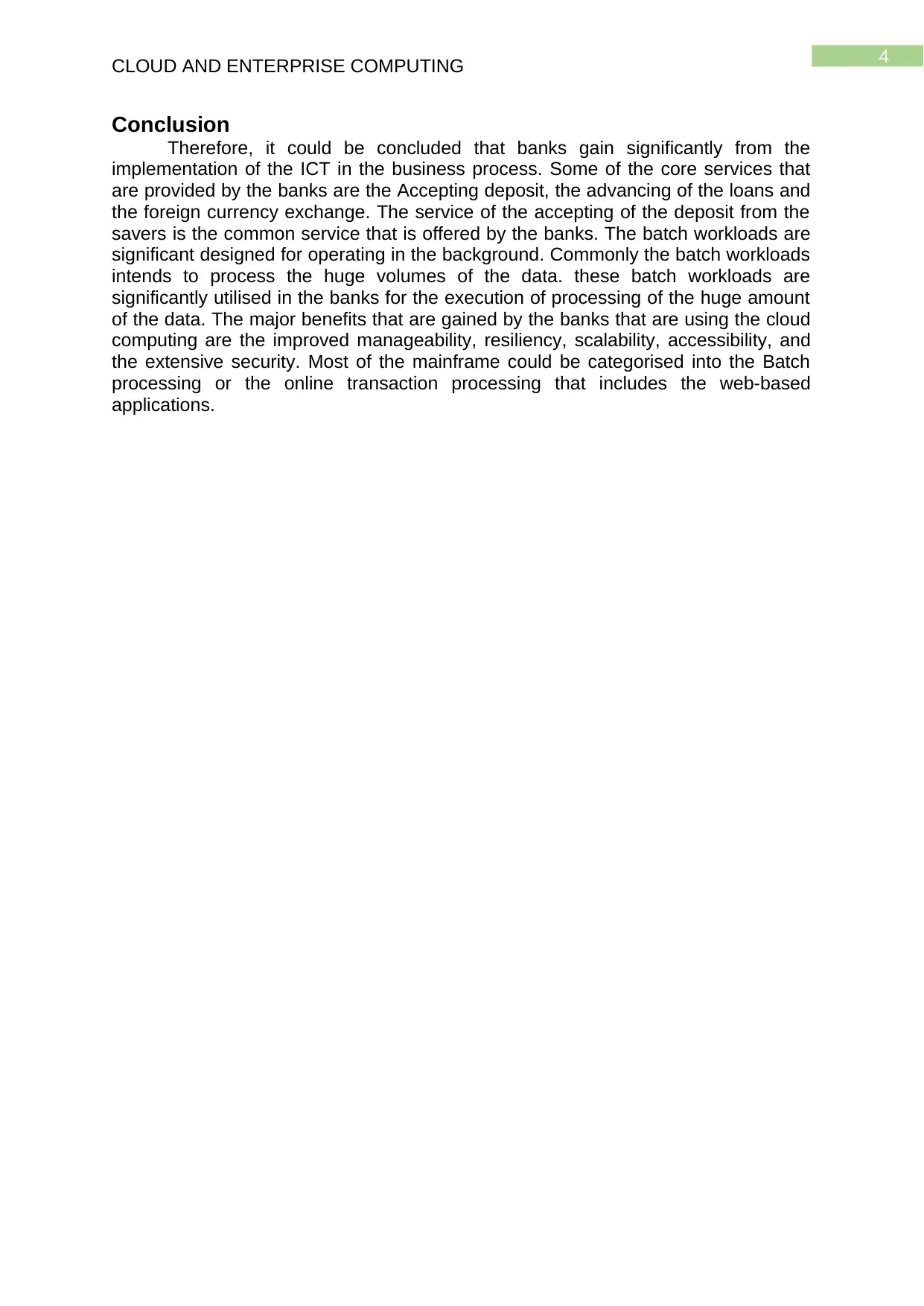
4
CLOUD AND ENTERPRISE COMPUTING
Conclusion
Therefore, it could be concluded that banks gain significantly from the
implementation of the ICT in the business process. Some of the core services that
are provided by the banks are the Accepting deposit, the advancing of the loans and
the foreign currency exchange. The service of the accepting of the deposit from the
savers is the common service that is offered by the banks. The batch workloads are
significant designed for operating in the background. Commonly the batch workloads
intends to process the huge volumes of the data. these batch workloads are
significantly utilised in the banks for the execution of processing of the huge amount
of the data. The major benefits that are gained by the banks that are using the cloud
computing are the improved manageability, resiliency, scalability, accessibility, and
the extensive security. Most of the mainframe could be categorised into the Batch
processing or the online transaction processing that includes the web-based
applications.
CLOUD AND ENTERPRISE COMPUTING
Conclusion
Therefore, it could be concluded that banks gain significantly from the
implementation of the ICT in the business process. Some of the core services that
are provided by the banks are the Accepting deposit, the advancing of the loans and
the foreign currency exchange. The service of the accepting of the deposit from the
savers is the common service that is offered by the banks. The batch workloads are
significant designed for operating in the background. Commonly the batch workloads
intends to process the huge volumes of the data. these batch workloads are
significantly utilised in the banks for the execution of processing of the huge amount
of the data. The major benefits that are gained by the banks that are using the cloud
computing are the improved manageability, resiliency, scalability, accessibility, and
the extensive security. Most of the mainframe could be categorised into the Batch
processing or the online transaction processing that includes the web-based
applications.
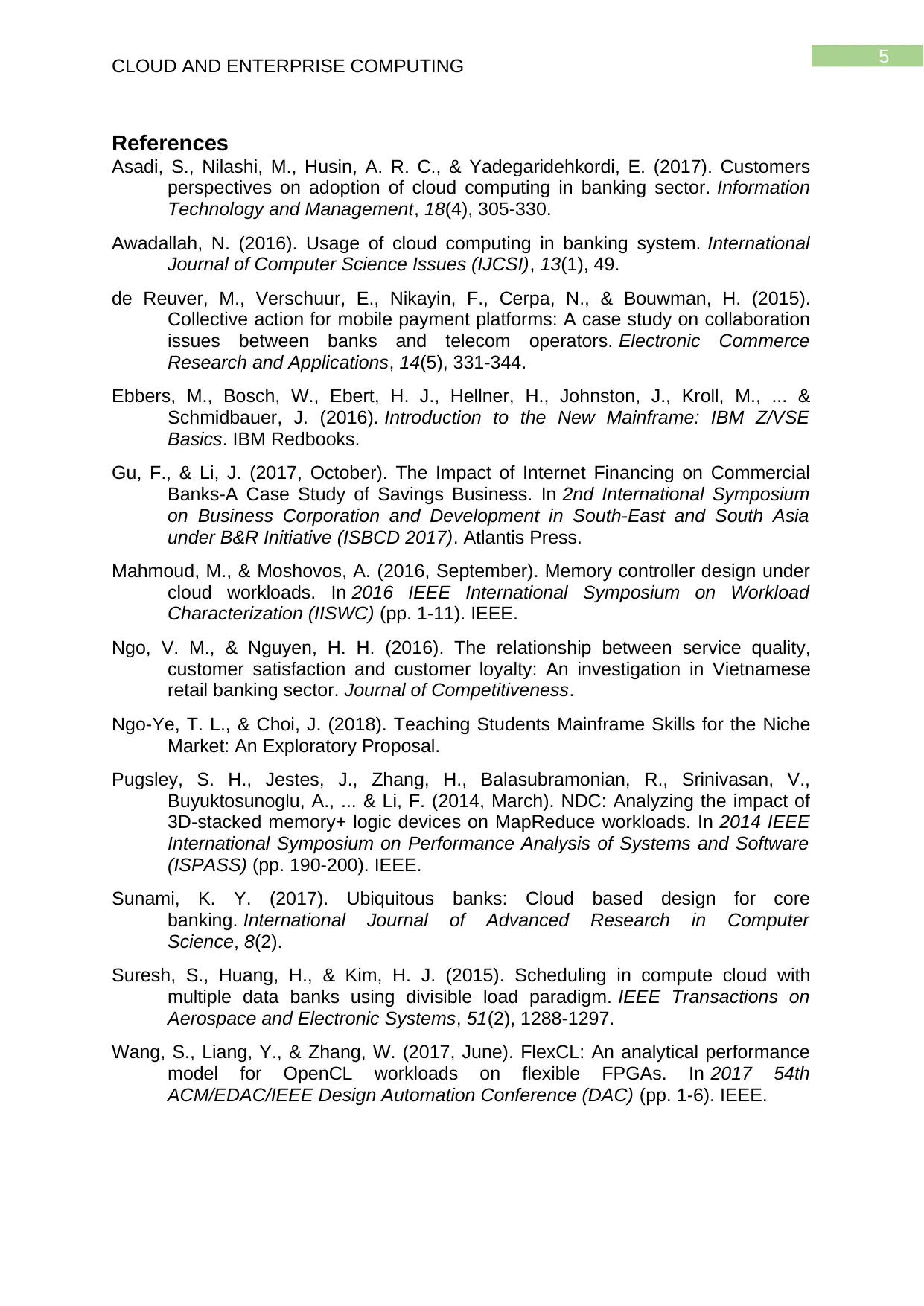
5
CLOUD AND ENTERPRISE COMPUTING
References
Asadi, S., Nilashi, M., Husin, A. R. C., & Yadegaridehkordi, E. (2017). Customers
perspectives on adoption of cloud computing in banking sector. Information
Technology and Management, 18(4), 305-330.
Awadallah, N. (2016). Usage of cloud computing in banking system. International
Journal of Computer Science Issues (IJCSI), 13(1), 49.
de Reuver, M., Verschuur, E., Nikayin, F., Cerpa, N., & Bouwman, H. (2015).
Collective action for mobile payment platforms: A case study on collaboration
issues between banks and telecom operators. Electronic Commerce
Research and Applications, 14(5), 331-344.
Ebbers, M., Bosch, W., Ebert, H. J., Hellner, H., Johnston, J., Kroll, M., ... &
Schmidbauer, J. (2016). Introduction to the New Mainframe: IBM Z/VSE
Basics. IBM Redbooks.
Gu, F., & Li, J. (2017, October). The Impact of Internet Financing on Commercial
Banks-A Case Study of Savings Business. In 2nd International Symposium
on Business Corporation and Development in South-East and South Asia
under B&R Initiative (ISBCD 2017). Atlantis Press.
Mahmoud, M., & Moshovos, A. (2016, September). Memory controller design under
cloud workloads. In 2016 IEEE International Symposium on Workload
Characterization (IISWC) (pp. 1-11). IEEE.
Ngo, V. M., & Nguyen, H. H. (2016). The relationship between service quality,
customer satisfaction and customer loyalty: An investigation in Vietnamese
retail banking sector. Journal of Competitiveness.
Ngo-Ye, T. L., & Choi, J. (2018). Teaching Students Mainframe Skills for the Niche
Market: An Exploratory Proposal.
Pugsley, S. H., Jestes, J., Zhang, H., Balasubramonian, R., Srinivasan, V.,
Buyuktosunoglu, A., ... & Li, F. (2014, March). NDC: Analyzing the impact of
3D-stacked memory+ logic devices on MapReduce workloads. In 2014 IEEE
International Symposium on Performance Analysis of Systems and Software
(ISPASS) (pp. 190-200). IEEE.
Sunami, K. Y. (2017). Ubiquitous banks: Cloud based design for core
banking. International Journal of Advanced Research in Computer
Science, 8(2).
Suresh, S., Huang, H., & Kim, H. J. (2015). Scheduling in compute cloud with
multiple data banks using divisible load paradigm. IEEE Transactions on
Aerospace and Electronic Systems, 51(2), 1288-1297.
Wang, S., Liang, Y., & Zhang, W. (2017, June). FlexCL: An analytical performance
model for OpenCL workloads on flexible FPGAs. In 2017 54th
ACM/EDAC/IEEE Design Automation Conference (DAC) (pp. 1-6). IEEE.
CLOUD AND ENTERPRISE COMPUTING
References
Asadi, S., Nilashi, M., Husin, A. R. C., & Yadegaridehkordi, E. (2017). Customers
perspectives on adoption of cloud computing in banking sector. Information
Technology and Management, 18(4), 305-330.
Awadallah, N. (2016). Usage of cloud computing in banking system. International
Journal of Computer Science Issues (IJCSI), 13(1), 49.
de Reuver, M., Verschuur, E., Nikayin, F., Cerpa, N., & Bouwman, H. (2015).
Collective action for mobile payment platforms: A case study on collaboration
issues between banks and telecom operators. Electronic Commerce
Research and Applications, 14(5), 331-344.
Ebbers, M., Bosch, W., Ebert, H. J., Hellner, H., Johnston, J., Kroll, M., ... &
Schmidbauer, J. (2016). Introduction to the New Mainframe: IBM Z/VSE
Basics. IBM Redbooks.
Gu, F., & Li, J. (2017, October). The Impact of Internet Financing on Commercial
Banks-A Case Study of Savings Business. In 2nd International Symposium
on Business Corporation and Development in South-East and South Asia
under B&R Initiative (ISBCD 2017). Atlantis Press.
Mahmoud, M., & Moshovos, A. (2016, September). Memory controller design under
cloud workloads. In 2016 IEEE International Symposium on Workload
Characterization (IISWC) (pp. 1-11). IEEE.
Ngo, V. M., & Nguyen, H. H. (2016). The relationship between service quality,
customer satisfaction and customer loyalty: An investigation in Vietnamese
retail banking sector. Journal of Competitiveness.
Ngo-Ye, T. L., & Choi, J. (2018). Teaching Students Mainframe Skills for the Niche
Market: An Exploratory Proposal.
Pugsley, S. H., Jestes, J., Zhang, H., Balasubramonian, R., Srinivasan, V.,
Buyuktosunoglu, A., ... & Li, F. (2014, March). NDC: Analyzing the impact of
3D-stacked memory+ logic devices on MapReduce workloads. In 2014 IEEE
International Symposium on Performance Analysis of Systems and Software
(ISPASS) (pp. 190-200). IEEE.
Sunami, K. Y. (2017). Ubiquitous banks: Cloud based design for core
banking. International Journal of Advanced Research in Computer
Science, 8(2).
Suresh, S., Huang, H., & Kim, H. J. (2015). Scheduling in compute cloud with
multiple data banks using divisible load paradigm. IEEE Transactions on
Aerospace and Electronic Systems, 51(2), 1288-1297.
Wang, S., Liang, Y., & Zhang, W. (2017, June). FlexCL: An analytical performance
model for OpenCL workloads on flexible FPGAs. In 2017 54th
ACM/EDAC/IEEE Design Automation Conference (DAC) (pp. 1-6). IEEE.
⊘ This is a preview!⊘
Do you want full access?
Subscribe today to unlock all pages.

Trusted by 1+ million students worldwide
1 out of 6
Related Documents
Your All-in-One AI-Powered Toolkit for Academic Success.
+13062052269
info@desklib.com
Available 24*7 on WhatsApp / Email
![[object Object]](/_next/static/media/star-bottom.7253800d.svg)
Unlock your academic potential
Copyright © 2020–2025 A2Z Services. All Rights Reserved. Developed and managed by ZUCOL.





